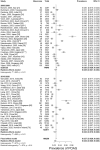Prevalence of primary open angle glaucoma in the last 20 years: a meta-analysis and systematic review
- PMID: 34215769
- PMCID: PMC8253788
- DOI: 10.1038/s41598-021-92971-w
Prevalence of primary open angle glaucoma in the last 20 years: a meta-analysis and systematic review
Abstract
Primary open-angle glaucoma (POAG) is a leading cause of irreversible blindness in the world and is influenced by various sociodemographic factors. This meta-analysis aims to determine the worldwide prevalence of POAG in the adult general population for the last 20 years, and explore variation in prevalence by age, gender and geographical location. An electronic literature search was performed using the PubMed, Embase, and Web of Science databases. Population-based cross-sectional or cohort studies published in the last 20 years (2000-2020) that reported prevalence of POAG were recruited. Relevant studies meeting defined eligibility criteria were selected and reviewed systematically by meta-analysis. The prevalence of POAG was analyzed according to various risk factors. A random effect model was used for the meta-analysis. Fifty publications with a total of 198,259 subjects were included in this meta-analysis. The worldwide overall prevalence of POAG was 2.4% (95% CI 2.0 ~ 2.8%). The prevalence increases with age. Men are found to be more susceptible to POAG than women (RR 1.28, p < 0.01). Africa is found to have the highest prevalence of POAG (4.0%) among all continents. The current estimated global population of POAG is 68.56 million (95% CI 59.99 ~ 79.98). POAG is a worldwide vision threatening disease with high prevalence for the last 20 years. The population-based prevalence of POAG varies widely across individual studies, due to variations in risk factors of age, gender, and population geographic location.
Conflict of interest statement
The authors declare no competing interests.
Figures





References
Publication types
MeSH terms
LinkOut - more resources
Full Text Sources
Medical

